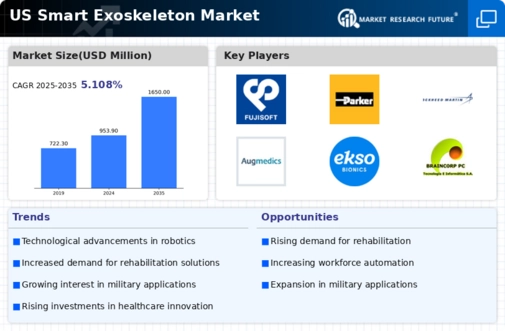The US Smart Exoskeleton Market is rapidly evolving, driven by advancements in robotics, artificial intelligence, and materials science. Competitive insights highlight a landscape characterized by innovation, strategic partnerships, and a focus on improving mobility and rehabilitation for users. Companies are increasingly investing in research and development to create exoskeletons that offer enhanced functionalities, better user experience, and accessibility for various applications, particularly in healthcare and industrial settings. The market includes both established players and new entrants that are leveraging technology to differentiate their products and gain a competitive edge.
This competitive environment is further intensified by the growing demand for assistive devices among an aging population and the rising acknowledgment of exoskeletons as a vital tool for rehabilitation and productivity enhancement. Fujisoft has positioned itself as a notable entity within the US Smart Exoskeleton Market, focusing on development and innovation tailored specifically for the needs of users in rehabilitation and industrial applications. The company leverages its expertise in robotics to create smart exoskeleton solutions that enhance user mobility and support recovery processes, which distinguishes it from competitors.
Fujisoft’s strength lies in its advanced technological capabilities, as well as its ongoing commitment to improving the design and functionality of its products. The company's presence in the US market has been marked by strategic collaborations with healthcare providers that amplify its reach and impact, ensuring that its cutting-edge products can effectively meet the diverse needs of users seeking mobility assistance or rehabilitation complements. Parker Hannifin is a significant player in the US Smart Exoskeleton Market, known for its strong engineering capabilities and innovative product lines that enhance user experience in both industrial and medical environments.
The company offers a range of exoskeleton solutions tailored for various applications, including workplace ergonomics and rehabilitation support. Parker Hannifin’s strengths lie in its robust research and development framework, allowing for continuous innovation in smart exoskeleton technology. The company has also engaged in strategic mergers and acquisitions, which have augmented its technological expertise and market presence in the US.
With a focus on high-quality engineering and a commitment to sustainability, Parker Hannifin continues to strengthen its footprint in the smart exoskeleton sector, positioning itself as a leader in providing cutting-edge solutions that meet the demands of modern mobility and productivity challenges.



















